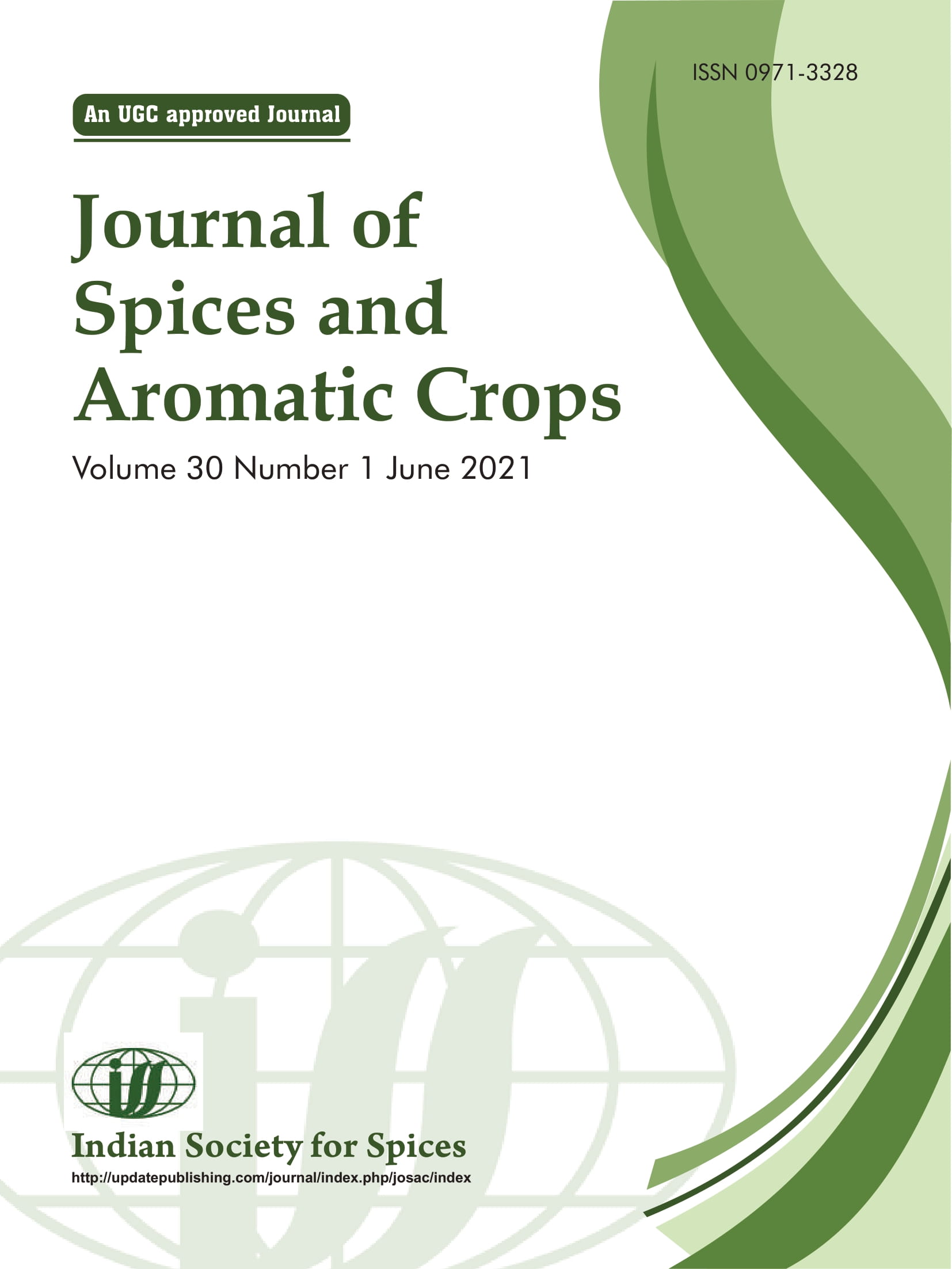A modified semi-selective medium for isolation and enumeration of Pochonia chlamydosporia (Goddard) Zare & W. Gams
A semi-selective medium for Pochonia chlamydosporia
DOI:
https://doi.org/10.25081/josac.2021.v30.i1.6923Keywords:
biological control, Pochonia chlamydosporia, quantification, semi-selectie mediumAbstract
Pochonia chlamydosporia, is one of the most promising biological control agents for managing phytoparasitic nematodes. Isolation and enumeration of viable colonies of P. chlamydosporia from soil and other substrates without contamination is a major limitation, when commonly available nutrient media are used. Development of a suitable selective/semi-selective media by incorporating one or more inhibitors of microbial growth can facilitate isolation of the fungus. In vitro studies were carried out to test the compatibility of commonly used pesticides, namely, metalaxyl, metalaxyl-mancozeb, carbendazim, copper oxychloride, and chlorpyrifos with P. chlamydosporia. The fungus showed relatively high tolerance to higher doses of metalaxyl and carbendazim and was used in the modified medium for better suppression of other soil borne fungi. In the present study, Kerry’s semi-selective medium was modified and evaluated by counting the viable fungal propagules in different substrates (rice, farmyard manure, maize, rice bran, barley, and sorghum) and soil artificially inoculated with the fungus. The results showed that the modified Kerry’s semi-selective medium can effectively be used for isolation and quantification of P. chlamydosporia in routine studies.
Downloads
References
Aravind R, Eapen S J, Kumar A, Dinu A & Ramana K V 2010 Screening of endophytic bacteria and evaluation of selected isolates for suppression of burrowing nematode (Radopholus similis Thorne) using three varieties of black pepper (Piper nigrum L.). Crop Prot. 29: 318-324.
Atkins S D, Hidalgo-Diaz L, Clark I M, Morton C O, De Oca N M, Gray P A & Kerry B R 2003a Approaches for monitoring the release of Pochonia chlamydosporia var. catenulata, a biocontrol agent of root-knot nematodes. Mycol. Res. 107: 206-212.
Atkins S D, Hidalgo-Diaz L, Kalisz H, Mauchline T H, Hirsch P R & Kerry B R 2003b Development of a new management strategy for the control of root-knot nematodes (Meloidogyne spp.) in organic vegetable production. Pest Manag. Sci. 59: 183-189.
Bourne J M, Kerry B R & De Leij F A A M 1994 Methods for the study of Verticillium chlamydosporium in the rhizosphere. J. Nematol. 26: 587–591.
Bruin G C A & Edgington L V 1981 Adaptive resistance in Peronosporales to metalaxyl. Can. J. Plant Pathol. 3: 201-206.
Dong L Q & Zhang K Q 2006 Microbial control of plant-parasitic nematodes: a fie-party interaction. Plant Soil 288: 31-45.
Esteves I, Peteira B, Atkins S D, Magan N & Kerry B 2009 Production of extracellular enzymes by different isolates of Pochonia chlamydosporia. Mycol. Res. 113: 867-876.
Fourie H, Ahuja P, Lammers J & Daneel M 2016 Brassicacea-based management strategies as an alternative to combat nematode pests: A synopsis. Crop Prot. 80: 21-41.
Hidalgo-Díaz L, Bourne J M, Kerry B R & Rodríguez M G 2000 Nematophagous Verticillium spp. in soils infested with Meloidogyne spp. in Cuba: isolation and screening. Int. J. Pest Manag. 46: 277-284.
Jacobs H, Gray S N & Crump D H 2003 Interactions between nematophagous fungi and consequences for their potential as biological agents for the control of potato cyst nematodes. Mycol. Res. 107: 47-56.
Kerry B R 2000 Rhizosphere interactions and the exploitation of microbial agents for the biological control of plant-parasitic nematodes. Annu. Rev. Phytopathol. 38: 423-441.
Kerry B R, Kirkwood I A, De Leij F A A M, Barba J, Leijdens M B & Brookes P C 1993 Growth and survival of Verticillium chlamydosporium Goddard, a parasite of nematodes, in soil. Biocontrol Sci. Technol. 3: 355-365.
Manzanilla-López R H, Esteves I, Powers S J & Kerry B R 2011. Effects of crop plants on abundance of Pochonia chlamydosporia and other fungal parasites of root-knot and potato cyst nematodes. Ann. Appl. Biol. 159: 118-129.
Manzanilla-López R H & Lopez-Llorca L V (Eds.) 2017 Perspectives in Sustainable Nematode Management Through Pochonia chlamydosporia: Applications for Root and Rhizosphere Health. Springer. 411 pp.
Mauchline T H, Kerry B R & Hirsch P R 2002 Quantification in soil and the rhizosphere of the nematophagous fungus Verticillium chlamydosporium by competitive PCR and comparison with selective plating. Appl. Environ. Microbiol. 68: 1846-1853.
Mauchline T H, Kerry B R & Hirsch P R 2004 The biocontrol fungus Pochonia chlamydosporia shows nematode host preference at the infraspecific level. Mycol. Res. 108: 161-169.
Mensin S, Soytong K, McGovern R J & Toanun C 2013 Effectof agricultural pesticides on the growth and sporulation of nematophagous fungi. J. Agric. Technol. 9: 953-961.
Morton C O, Mauchline T H, Kerry R & Hirsch P R 2003 PCR-based DNA fingerprinting indicates host-related genetic variation n the nematophagous fungus Pochonia chlamydosporia. Mycol. Res. 107: 198-205.
Siddiqui I A, Atkins S D & Kerry B R 2009 Relationship between saprotrophic growth in soil of different biotypes of Pochonia chlamydosporia and the infection of nematode eggs. Ann. Appl. Biol. 155: 131-141.
Sung G H, Hywel Jones N L, & Sung J M 2007 Phylogenetic classification of Cordyceps and the clavicipitaceous fungi. Stud. Mycol. 57: 5-59.
Zare R, Gams W & Evans H C 2001 A revision of Verticillium section Prostrata. V. The genus Pochonia, with notes on Rotiferophthora. Nova Hedwigia 73: 51-86.
Published
How to Cite
Issue
Section
Copyright (c) 2021 M K Rincy, R Praveena, S J Eapen

This work is licensed under a Creative Commons Attribution-NonCommercial-NoDerivatives 4.0 International License.






 .
.